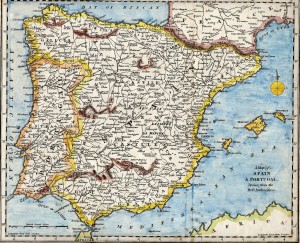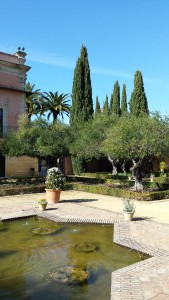Regular readers of this web-site will know that I have been trying to find a snappy and evocative new title for my next book – an adventure story ( see Entitlement – the search for a title ). Formerly called ‘On the Frontier’ the book was originally written in serial form many years ago for my nephew. It  has subsequently been re-written and is now a very different story. It also has a new name – ‘Reconquista‘.
has subsequently been re-written and is now a very different story. It also has a new name – ‘Reconquista‘.
The Reconquista is the term used by historians and others for the gradual re-taking of the Iberian peninsular from its Moorish overlords. Originally the territory of a loose collaboration of Visigothic tribes, Hispania was invaded when Tariq ibn Ziyad and his army of arabs and berbers crossed what we  now call the straits of Gibraltar ( Jebel Tariq, the mountain of Tariq ) in 711. The Visigothic King, Roderigo, was defeated in battle near the Guadelete River near to modern-day Jerez de la Frontera. The creation of the Caliphate and Al Andalus followed, with Moorish armies getting as far north as the River Garonne in modern-day France.
now call the straits of Gibraltar ( Jebel Tariq, the mountain of Tariq ) in 711. The Visigothic King, Roderigo, was defeated in battle near the Guadelete River near to modern-day Jerez de la Frontera. The creation of the Caliphate and Al Andalus followed, with Moorish armies getting as far north as the River Garonne in modern-day France.
 Thereafter fighting in southern France and northern Spain never really stopped altogether and often the sides weren’t split along religious lines at all. But it was during the era of the Crusades that Christian knights and princes were encouraged to religious wage war on Al Andalus. Christian kingdoms, like Leon, Navarre, Castile and Aragon were established in the north with Portugal in the west. While waves of north African invaders, the Almorovids and the Almohads, took over, then lost control of the Caliphate. None the less, things weren’t clear-cut and often Christians fought on the same side as Muslims, against other Christians and Muslims. By the opening of ‘Reconquista‘, however, most of the southlands west of the mountains was under Christian control. The Emirate of Granada, east of the mountains, lasted until 1492 and capitulation to Fernando and Isabel.
Thereafter fighting in southern France and northern Spain never really stopped altogether and often the sides weren’t split along religious lines at all. But it was during the era of the Crusades that Christian knights and princes were encouraged to religious wage war on Al Andalus. Christian kingdoms, like Leon, Navarre, Castile and Aragon were established in the north with Portugal in the west. While waves of north African invaders, the Almorovids and the Almohads, took over, then lost control of the Caliphate. None the less, things weren’t clear-cut and often Christians fought on the same side as Muslims, against other Christians and Muslims. By the opening of ‘Reconquista‘, however, most of the southlands west of the mountains was under Christian control. The Emirate of Granada, east of the mountains, lasted until 1492 and capitulation to Fernando and Isabel.
So the book title indicates setting and historical period, one of turmoil and conflict. It opens on 9th October, 1264, the day King Alfonso X, of Castille and Leon, marches into the city of Jerez. This is also the day of Saint Denis, or San Dionysio, the patron saint of the city and he and King Alfonso are celebrated every year on that day in Jerez, with a church service in Mudejar church of San Dionysio, near Plateros, followed and preceded by processions, music and general enjoyment.
and Leon, marches into the city of Jerez. This is also the day of Saint Denis, or San Dionysio, the patron saint of the city and he and King Alfonso are celebrated every year on that day in Jerez, with a church service in Mudejar church of San Dionysio, near Plateros, followed and preceded by processions, music and general enjoyment.
Thank you to all of those people who made suggestions for a title, some of which were excellent, if not entirely suitable for my book – ‘Blood on the Scimitar’ springs to mind. Of the five options listed in an earlier blog post, ‘No Place of Safety’ and ‘The Silver Rings’ were liked, ‘After the Siege’ and ‘Flight from Frontera’ were, by and large, not. But the title ‘Reconquista‘ prevailed, supported, not least, by my editor and by some of our friends in Jerez de la Frontera itself.
If you would like to learn more about the historical sources for the book, try the post Wanted, book researcher…. Alternatively, other posts about the book and its setting are Verano en Jerez Story of a Journey


 RSS – Posts
RSS – Posts